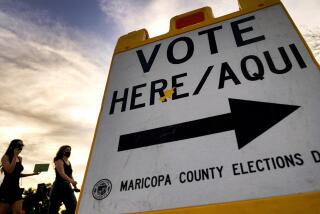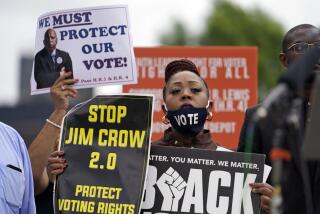Review: ‘Give Us the Ballot’ is a sobering look at the modern struggle for voting rights in America
Fifty years after passage of the Voting Rights Act, “Give Us the Ballot” makes a powerful case that voting rights are under assault in 21st century America. Current events underscore the book’s timeliness. In September, Alabama announced it was closing 31 driver’s license offices, a disproportionate number of them in majority-black counties, making it even harder for African Americans to comply with Alabama’s 2011 law requiring voters to show government-issued IDs to cast ballots. As author Ari Berman points out, Alabama is one of nine Republican-controlled states to pass voter ID laws since 2010, and those are only the most blatant of restrictions that also include limits on early voting and rules that make voter registration more difficult.
Efforts to roll back the act’s protections for minority voters are nothing new, Berman demonstrates; the first legal challenge to the law was filed five days after President Lyndon B. Johnson signed it in 1965. When the Supreme Court upheld the Voting Rights Act a year later, Southern legislators turned from preventing African Americans from voting to diluting their votes. Black-majority counties were consolidated with larger white ones; at-large elections and multi-member districts made it nearly impossible for African American candidates to gain office. Section 5 of the act, which required seven Southern states with histories of voting discrimination to submit any changes in their voting laws for federal review, became the Department of Justice Civil Rights Division’s instrument for preventing such manipulations.
“The work of the voting section shifted from making sure people could register and vote freely to stopping election changes that denied minority voters political representation,” Berman writes. “The VRA’s scope and impact increased dramatically.” But this shift garnered high-profile critics, including liberal-turned-neoconservative Abigail Thernstrom, who argued in an influential 1979 article in the magazine The Public Interest that Section 5 “betrayed the color-blind ideal the VRA was meant to advance.” The Reagan-era Justice Department seized on arguments like this to justify limiting civil rights enforcement to individual cases of intentional discrimination, which were difficult to prove.
Judging voting law changes on the basis of their discriminatory effects, wrote a hard-charging young lawyer in the Ronald Reagan administration named John Roberts, “would establish essentially a quota system for electoral politics.” The Roberts-orchestrated crusade against the “effects test” expansion of the Voting Rights Act failed in 1982, when Congress passed a 25-year-extension, but the seeds of the counterrevolution had been sown.
They were watered by Republican National Committee chair Lee Atwater, who in 1990 developed a cynical strategy to advocate the creation of majority-black districts in the South so that the other districts would become whiter, more conservative and, he hoped, Republican. The ill-advised decision of civil rights groups to support this strategy was vehemently rebuffed by the African American co-chair of North Carolina’s redistricting committee, who warned that black voters would “find themselves confined to ‘political reservations’ with less political influence than they have today.”
Majority-minority districts did elect more people of color to local governing bodies, state houses and the U.S. Congress. But they gave the Voting Rights Act’s opponents a potent tool for recasting a law designed to redress past and present injustices as a “perpetuation of racial entitlement.” Those were the words of Justice Antonin Scalia during the oral arguments in Shelby County vs. Holder, which resulted in the Supreme Court’s 2013 decision making Section 5 unenforceable. By now, Roberts was chief justice, having said during his 2005 confirmation hearings when pressed about his views on the Voting Rights Act, “the constitutionality has been upheld, and I don’t have any issue with that.”
The increasingly diverse electorate fostered by the act had made Barack Obama president, but it had also prompted a backlash of voting-restrictive legislation across the country. Anti-VRA activists could be astonishingly frank about their motives. “I don’t want everybody to vote,” said the founder of the American Legislative Exchange Council, which helped orchestrate more than half the voter ID bills introduced in 2011-12. “Our leverage in elections quite candidly goes up as the voting populace goes down.”
And go down it did in wake of the Shelby decision. Berman closes with a grim catalog of Shelby’s consequences. As he has done throughout, he mingles statistics — 800,000 registered voters in Texas lacked acceptable ID under its new law — with personal stories of the disenfranchised, such as the 83-year-old mail carrier turned away at the polls in the Texas county where he had lived and voted for 60 years. There’s no question about the author’s political point of view (Berman is a contributing writer for the Nation and a fellow at the Nation Institute), but he buttresses his scathing indictment with extensive documentation. National voter turnout fell to its lowest level since 1942 in the 2014 midterm elections, and the new barriers to voting may well have provided the margin of victory in close races.
It’s not a happy ending, though Berman strains to find hope in the renewed commitment to voter registration of a younger generation of civil rights activists galvanized by Shelby and the restrictive laws it enabled. They will need that commitment to combat the organized opposition to expansive voting rights whose 50-year history is traced in this important and deeply distressing book.
::
Give Us the Ballot: The Modern Struggle for Voting Rights in America
Ari Berman
Farrar, Straus & Giroux: 372 pp., $28
Smith is a contributing editor at the American Scholar.
More to Read
The biggest entertainment stories
Get our big stories about Hollywood, film, television, music, arts, culture and more right in your inbox as soon as they publish.
You may occasionally receive promotional content from the Los Angeles Times.










